Communication Strategies in Business: Marks and Spencer Report
VerifiedAdded on 2020/10/22
|11
|2830
|474
Report
AI Summary
This report provides a comprehensive analysis of communication strategies within a business context, using Marks and Spencer as a case study. It delves into the communication needs of both internal and external stakeholders, exploring various communication models such as Shannon's model, and assessing the effectiveness of different communication systems including circle, chain, and wheel models. The report further examines factors influencing the choice of communication media, the importance of correct grammar and structure, and strategies for overcoming communication barriers. It also discusses the application of communication theories, the significance of body language, and proofreading techniques. The report identifies the purpose and audience of communication, appropriate media choices, and the importance of adhering to business practices and deadlines. The analysis covers the nature, purpose, and audience of information, emphasizing the use of correct language and body language to reinforce messages. Overall, the report highlights the crucial role of effective communication in business success, emphasizing clarity, accuracy, and adherence to organizational policies.
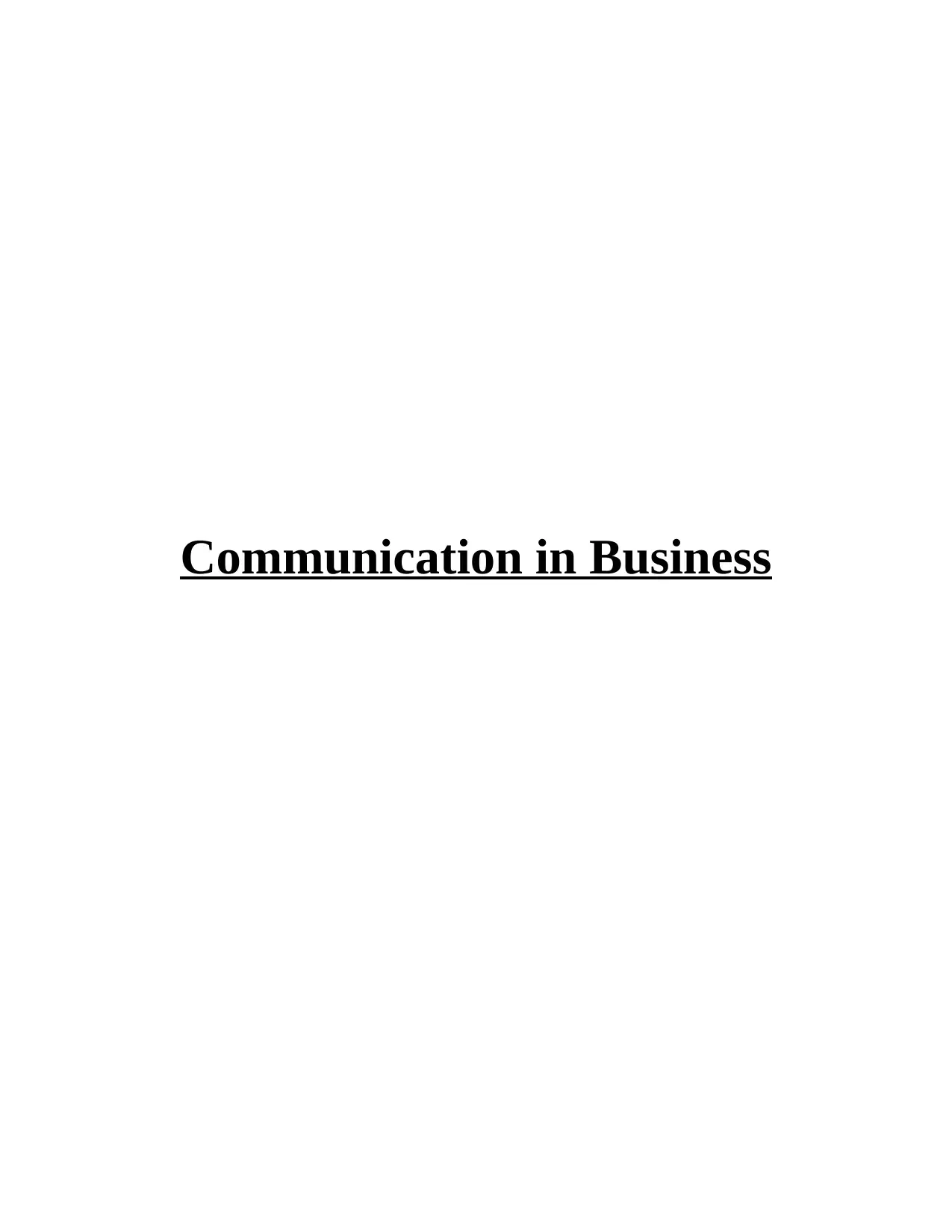
Communication in Business
Paraphrase This Document
Need a fresh take? Get an instant paraphrase of this document with our AI Paraphraser
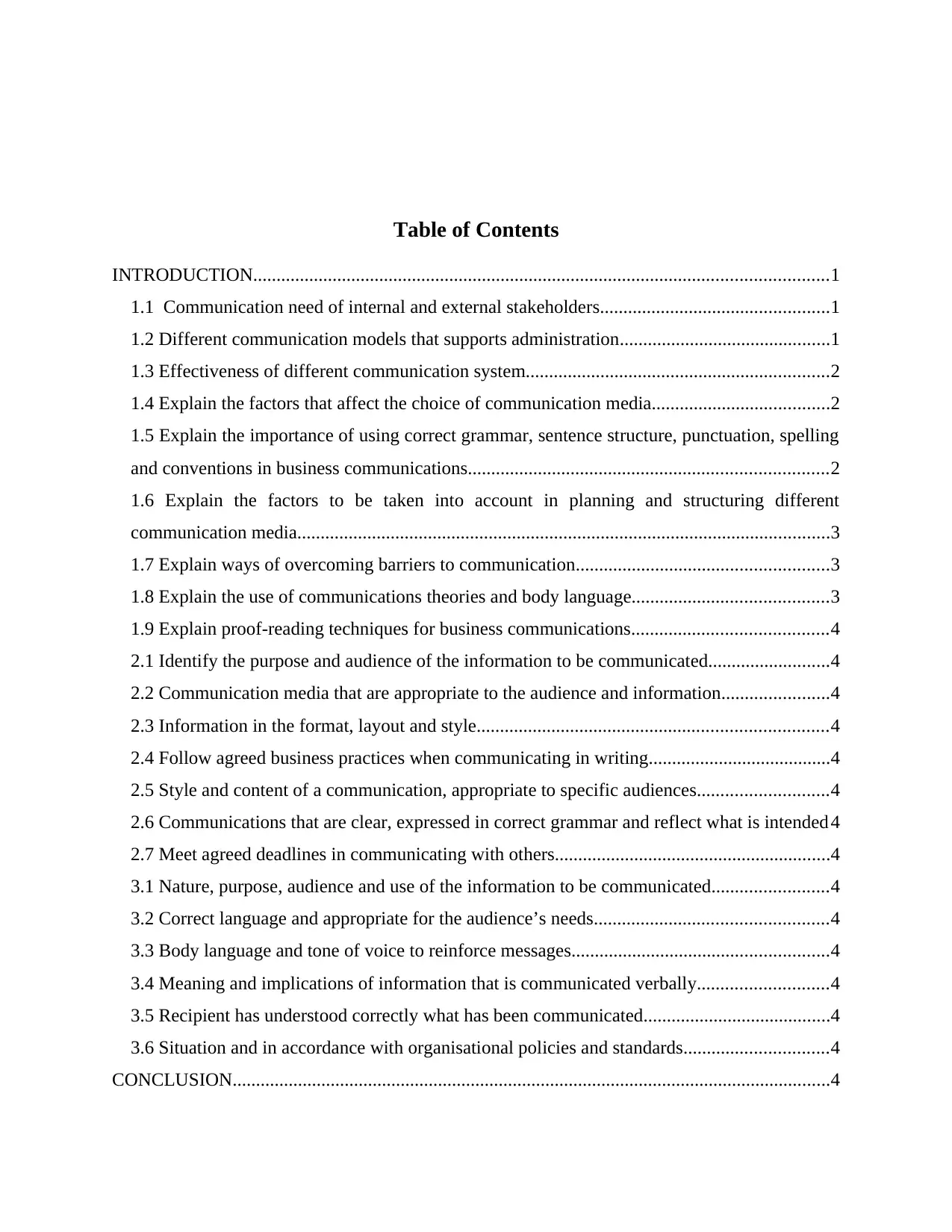
Table of Contents
INTRODUCTION...........................................................................................................................1
1.1 Communication need of internal and external stakeholders.................................................1
1.2 Different communication models that supports administration.............................................1
1.3 Effectiveness of different communication system.................................................................2
1.4 Explain the factors that affect the choice of communication media......................................2
1.5 Explain the importance of using correct grammar, sentence structure, punctuation, spelling
and conventions in business communications.............................................................................2
1.6 Explain the factors to be taken into account in planning and structuring different
communication media..................................................................................................................3
1.7 Explain ways of overcoming barriers to communication......................................................3
1.8 Explain the use of communications theories and body language..........................................3
1.9 Explain proof-reading techniques for business communications..........................................4
2.1 Identify the purpose and audience of the information to be communicated..........................4
2.2 Communication media that are appropriate to the audience and information.......................4
2.3 Information in the format, layout and style...........................................................................4
2.4 Follow agreed business practices when communicating in writing.......................................4
2.5 Style and content of a communication, appropriate to specific audiences............................4
2.6 Communications that are clear, expressed in correct grammar and reflect what is intended 4
2.7 Meet agreed deadlines in communicating with others...........................................................4
3.1 Nature, purpose, audience and use of the information to be communicated.........................4
3.2 Correct language and appropriate for the audience’s needs..................................................4
3.3 Body language and tone of voice to reinforce messages.......................................................4
3.4 Meaning and implications of information that is communicated verbally............................4
3.5 Recipient has understood correctly what has been communicated........................................4
3.6 Situation and in accordance with organisational policies and standards...............................4
CONCLUSION................................................................................................................................4
INTRODUCTION...........................................................................................................................1
1.1 Communication need of internal and external stakeholders.................................................1
1.2 Different communication models that supports administration.............................................1
1.3 Effectiveness of different communication system.................................................................2
1.4 Explain the factors that affect the choice of communication media......................................2
1.5 Explain the importance of using correct grammar, sentence structure, punctuation, spelling
and conventions in business communications.............................................................................2
1.6 Explain the factors to be taken into account in planning and structuring different
communication media..................................................................................................................3
1.7 Explain ways of overcoming barriers to communication......................................................3
1.8 Explain the use of communications theories and body language..........................................3
1.9 Explain proof-reading techniques for business communications..........................................4
2.1 Identify the purpose and audience of the information to be communicated..........................4
2.2 Communication media that are appropriate to the audience and information.......................4
2.3 Information in the format, layout and style...........................................................................4
2.4 Follow agreed business practices when communicating in writing.......................................4
2.5 Style and content of a communication, appropriate to specific audiences............................4
2.6 Communications that are clear, expressed in correct grammar and reflect what is intended 4
2.7 Meet agreed deadlines in communicating with others...........................................................4
3.1 Nature, purpose, audience and use of the information to be communicated.........................4
3.2 Correct language and appropriate for the audience’s needs..................................................4
3.3 Body language and tone of voice to reinforce messages.......................................................4
3.4 Meaning and implications of information that is communicated verbally............................4
3.5 Recipient has understood correctly what has been communicated........................................4
3.6 Situation and in accordance with organisational policies and standards...............................4
CONCLUSION................................................................................................................................4

REFERENCES................................................................................................................................5
⊘ This is a preview!⊘
Do you want full access?
Subscribe today to unlock all pages.

Trusted by 1+ million students worldwide
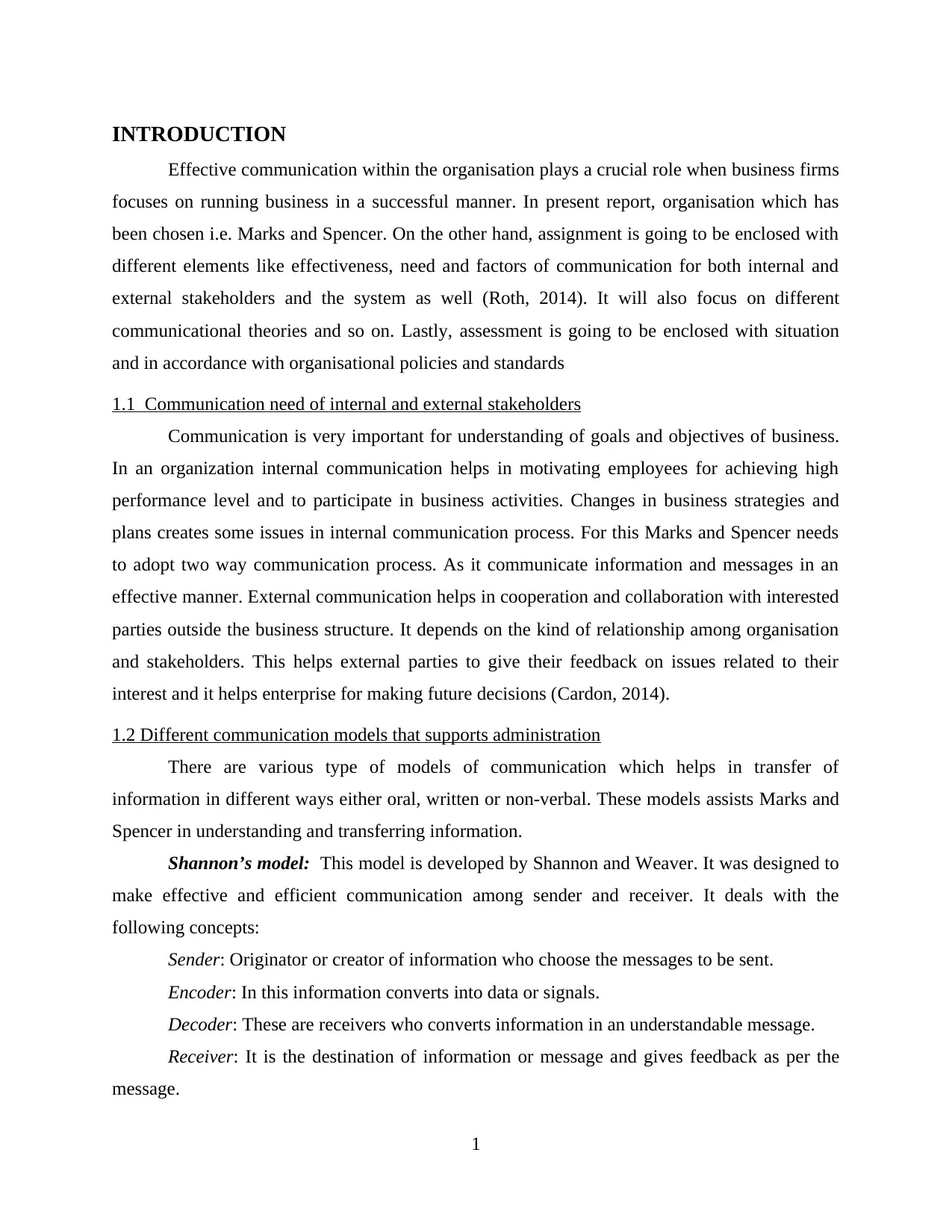
INTRODUCTION
Effective communication within the organisation plays a crucial role when business firms
focuses on running business in a successful manner. In present report, organisation which has
been chosen i.e. Marks and Spencer. On the other hand, assignment is going to be enclosed with
different elements like effectiveness, need and factors of communication for both internal and
external stakeholders and the system as well (Roth, 2014). It will also focus on different
communicational theories and so on. Lastly, assessment is going to be enclosed with situation
and in accordance with organisational policies and standards
1.1 Communication need of internal and external stakeholders
Communication is very important for understanding of goals and objectives of business.
In an organization internal communication helps in motivating employees for achieving high
performance level and to participate in business activities. Changes in business strategies and
plans creates some issues in internal communication process. For this Marks and Spencer needs
to adopt two way communication process. As it communicate information and messages in an
effective manner. External communication helps in cooperation and collaboration with interested
parties outside the business structure. It depends on the kind of relationship among organisation
and stakeholders. This helps external parties to give their feedback on issues related to their
interest and it helps enterprise for making future decisions (Cardon, 2014).
1.2 Different communication models that supports administration
There are various type of models of communication which helps in transfer of
information in different ways either oral, written or non-verbal. These models assists Marks and
Spencer in understanding and transferring information.
Shannon’s model: This model is developed by Shannon and Weaver. It was designed to
make effective and efficient communication among sender and receiver. It deals with the
following concepts:
Sender: Originator or creator of information who choose the messages to be sent.
Encoder: In this information converts into data or signals.
Decoder: These are receivers who converts information in an understandable message.
Receiver: It is the destination of information or message and gives feedback as per the
message.
1
Effective communication within the organisation plays a crucial role when business firms
focuses on running business in a successful manner. In present report, organisation which has
been chosen i.e. Marks and Spencer. On the other hand, assignment is going to be enclosed with
different elements like effectiveness, need and factors of communication for both internal and
external stakeholders and the system as well (Roth, 2014). It will also focus on different
communicational theories and so on. Lastly, assessment is going to be enclosed with situation
and in accordance with organisational policies and standards
1.1 Communication need of internal and external stakeholders
Communication is very important for understanding of goals and objectives of business.
In an organization internal communication helps in motivating employees for achieving high
performance level and to participate in business activities. Changes in business strategies and
plans creates some issues in internal communication process. For this Marks and Spencer needs
to adopt two way communication process. As it communicate information and messages in an
effective manner. External communication helps in cooperation and collaboration with interested
parties outside the business structure. It depends on the kind of relationship among organisation
and stakeholders. This helps external parties to give their feedback on issues related to their
interest and it helps enterprise for making future decisions (Cardon, 2014).
1.2 Different communication models that supports administration
There are various type of models of communication which helps in transfer of
information in different ways either oral, written or non-verbal. These models assists Marks and
Spencer in understanding and transferring information.
Shannon’s model: This model is developed by Shannon and Weaver. It was designed to
make effective and efficient communication among sender and receiver. It deals with the
following concepts:
Sender: Originator or creator of information who choose the messages to be sent.
Encoder: In this information converts into data or signals.
Decoder: These are receivers who converts information in an understandable message.
Receiver: It is the destination of information or message and gives feedback as per the
message.
1
Paraphrase This Document
Need a fresh take? Get an instant paraphrase of this document with our AI Paraphraser
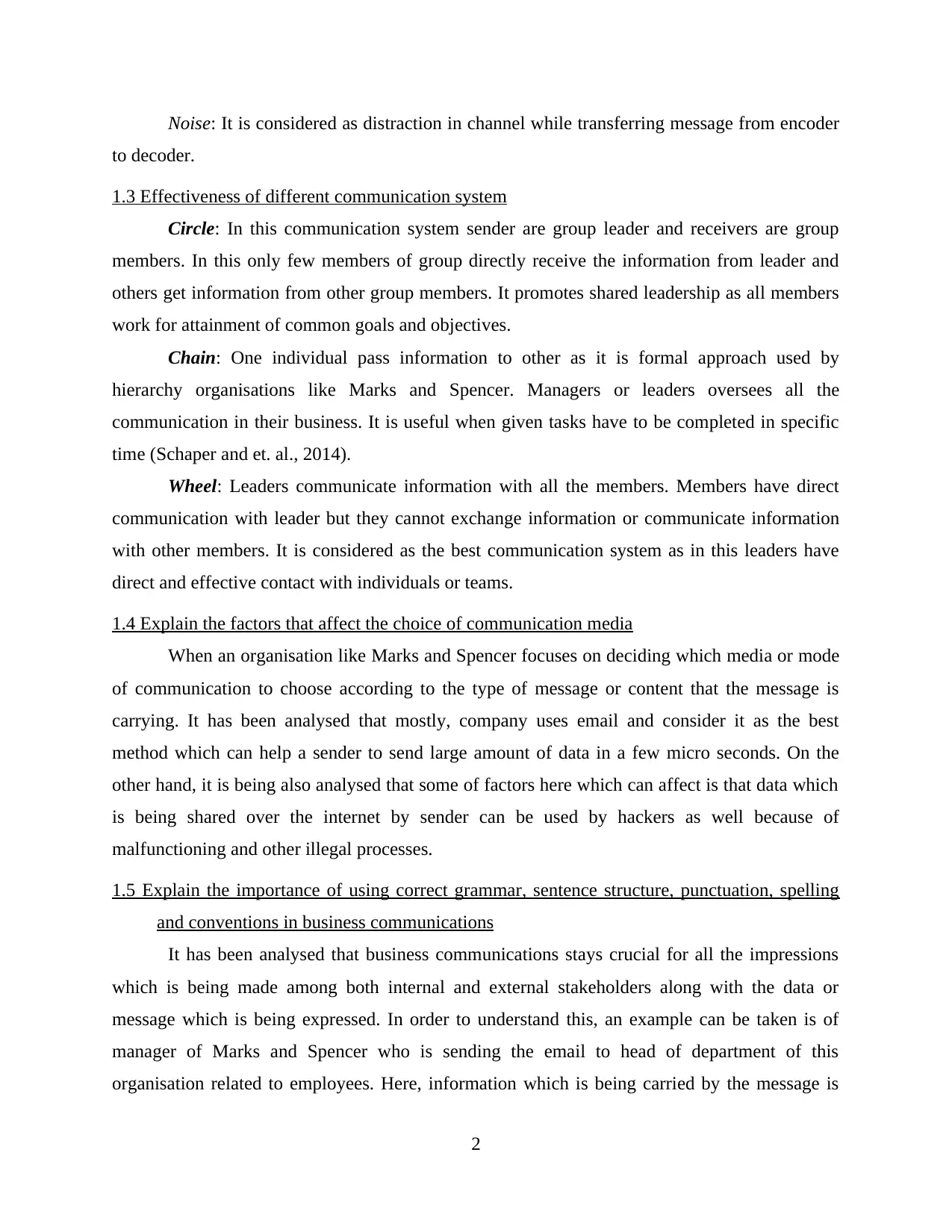
Noise: It is considered as distraction in channel while transferring message from encoder
to decoder.
1.3 Effectiveness of different communication system
Circle: In this communication system sender are group leader and receivers are group
members. In this only few members of group directly receive the information from leader and
others get information from other group members. It promotes shared leadership as all members
work for attainment of common goals and objectives.
Chain: One individual pass information to other as it is formal approach used by
hierarchy organisations like Marks and Spencer. Managers or leaders oversees all the
communication in their business. It is useful when given tasks have to be completed in specific
time (Schaper and et. al., 2014).
Wheel: Leaders communicate information with all the members. Members have direct
communication with leader but they cannot exchange information or communicate information
with other members. It is considered as the best communication system as in this leaders have
direct and effective contact with individuals or teams.
1.4 Explain the factors that affect the choice of communication media
When an organisation like Marks and Spencer focuses on deciding which media or mode
of communication to choose according to the type of message or content that the message is
carrying. It has been analysed that mostly, company uses email and consider it as the best
method which can help a sender to send large amount of data in a few micro seconds. On the
other hand, it is being also analysed that some of factors here which can affect is that data which
is being shared over the internet by sender can be used by hackers as well because of
malfunctioning and other illegal processes.
1.5 Explain the importance of using correct grammar, sentence structure, punctuation, spelling
and conventions in business communications
It has been analysed that business communications stays crucial for all the impressions
which is being made among both internal and external stakeholders along with the data or
message which is being expressed. In order to understand this, an example can be taken is of
manager of Marks and Spencer who is sending the email to head of department of this
organisation related to employees. Here, information which is being carried by the message is
2
to decoder.
1.3 Effectiveness of different communication system
Circle: In this communication system sender are group leader and receivers are group
members. In this only few members of group directly receive the information from leader and
others get information from other group members. It promotes shared leadership as all members
work for attainment of common goals and objectives.
Chain: One individual pass information to other as it is formal approach used by
hierarchy organisations like Marks and Spencer. Managers or leaders oversees all the
communication in their business. It is useful when given tasks have to be completed in specific
time (Schaper and et. al., 2014).
Wheel: Leaders communicate information with all the members. Members have direct
communication with leader but they cannot exchange information or communicate information
with other members. It is considered as the best communication system as in this leaders have
direct and effective contact with individuals or teams.
1.4 Explain the factors that affect the choice of communication media
When an organisation like Marks and Spencer focuses on deciding which media or mode
of communication to choose according to the type of message or content that the message is
carrying. It has been analysed that mostly, company uses email and consider it as the best
method which can help a sender to send large amount of data in a few micro seconds. On the
other hand, it is being also analysed that some of factors here which can affect is that data which
is being shared over the internet by sender can be used by hackers as well because of
malfunctioning and other illegal processes.
1.5 Explain the importance of using correct grammar, sentence structure, punctuation, spelling
and conventions in business communications
It has been analysed that business communications stays crucial for all the impressions
which is being made among both internal and external stakeholders along with the data or
message which is being expressed. In order to understand this, an example can be taken is of
manager of Marks and Spencer who is sending the email to head of department of this
organisation related to employees. Here, information which is being carried by the message is
2
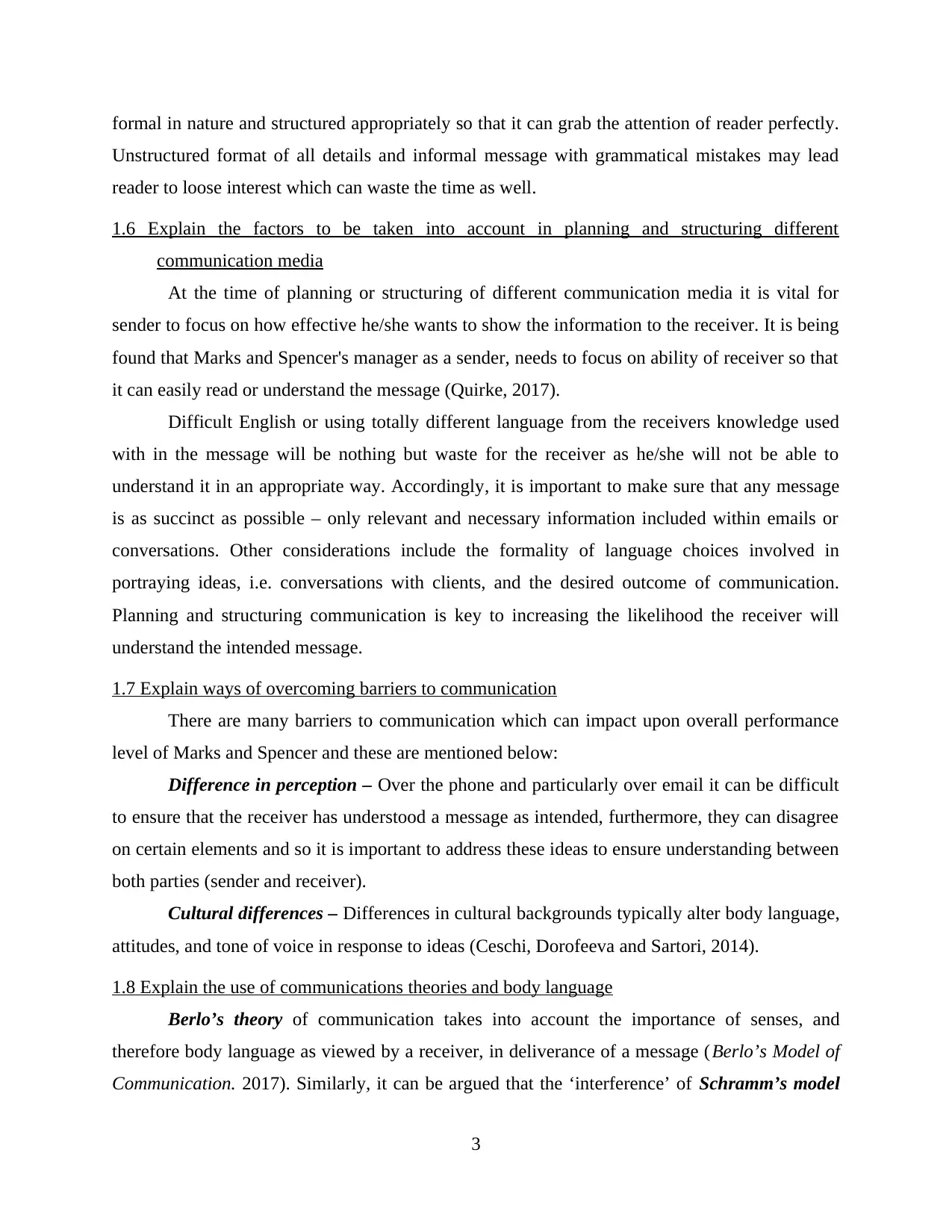
formal in nature and structured appropriately so that it can grab the attention of reader perfectly.
Unstructured format of all details and informal message with grammatical mistakes may lead
reader to loose interest which can waste the time as well.
1.6 Explain the factors to be taken into account in planning and structuring different
communication media
At the time of planning or structuring of different communication media it is vital for
sender to focus on how effective he/she wants to show the information to the receiver. It is being
found that Marks and Spencer's manager as a sender, needs to focus on ability of receiver so that
it can easily read or understand the message (Quirke, 2017).
Difficult English or using totally different language from the receivers knowledge used
with in the message will be nothing but waste for the receiver as he/she will not be able to
understand it in an appropriate way. Accordingly, it is important to make sure that any message
is as succinct as possible – only relevant and necessary information included within emails or
conversations. Other considerations include the formality of language choices involved in
portraying ideas, i.e. conversations with clients, and the desired outcome of communication.
Planning and structuring communication is key to increasing the likelihood the receiver will
understand the intended message.
1.7 Explain ways of overcoming barriers to communication
There are many barriers to communication which can impact upon overall performance
level of Marks and Spencer and these are mentioned below:
Difference in perception – Over the phone and particularly over email it can be difficult
to ensure that the receiver has understood a message as intended, furthermore, they can disagree
on certain elements and so it is important to address these ideas to ensure understanding between
both parties (sender and receiver).
Cultural differences – Differences in cultural backgrounds typically alter body language,
attitudes, and tone of voice in response to ideas (Ceschi, Dorofeeva and Sartori, 2014).
1.8 Explain the use of communications theories and body language
Berlo’s theory of communication takes into account the importance of senses, and
therefore body language as viewed by a receiver, in deliverance of a message (Berlo’s Model of
Communication. 2017). Similarly, it can be argued that the ‘interference’ of Schramm’s model
3
Unstructured format of all details and informal message with grammatical mistakes may lead
reader to loose interest which can waste the time as well.
1.6 Explain the factors to be taken into account in planning and structuring different
communication media
At the time of planning or structuring of different communication media it is vital for
sender to focus on how effective he/she wants to show the information to the receiver. It is being
found that Marks and Spencer's manager as a sender, needs to focus on ability of receiver so that
it can easily read or understand the message (Quirke, 2017).
Difficult English or using totally different language from the receivers knowledge used
with in the message will be nothing but waste for the receiver as he/she will not be able to
understand it in an appropriate way. Accordingly, it is important to make sure that any message
is as succinct as possible – only relevant and necessary information included within emails or
conversations. Other considerations include the formality of language choices involved in
portraying ideas, i.e. conversations with clients, and the desired outcome of communication.
Planning and structuring communication is key to increasing the likelihood the receiver will
understand the intended message.
1.7 Explain ways of overcoming barriers to communication
There are many barriers to communication which can impact upon overall performance
level of Marks and Spencer and these are mentioned below:
Difference in perception – Over the phone and particularly over email it can be difficult
to ensure that the receiver has understood a message as intended, furthermore, they can disagree
on certain elements and so it is important to address these ideas to ensure understanding between
both parties (sender and receiver).
Cultural differences – Differences in cultural backgrounds typically alter body language,
attitudes, and tone of voice in response to ideas (Ceschi, Dorofeeva and Sartori, 2014).
1.8 Explain the use of communications theories and body language
Berlo’s theory of communication takes into account the importance of senses, and
therefore body language as viewed by a receiver, in deliverance of a message (Berlo’s Model of
Communication. 2017). Similarly, it can be argued that the ‘interference’ of Schramm’s model
3
⊘ This is a preview!⊘
Do you want full access?
Subscribe today to unlock all pages.

Trusted by 1+ million students worldwide
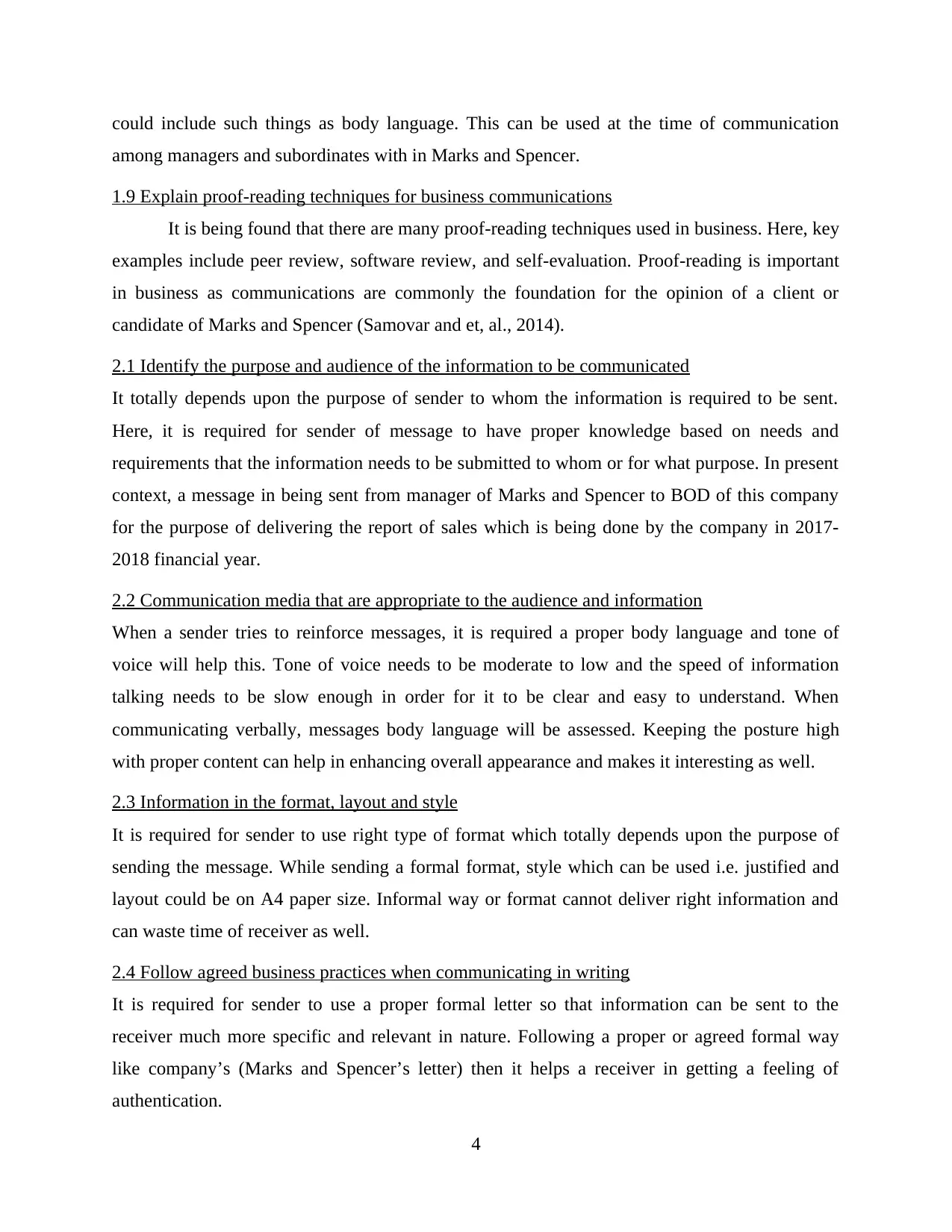
could include such things as body language. This can be used at the time of communication
among managers and subordinates with in Marks and Spencer.
1.9 Explain proof-reading techniques for business communications
It is being found that there are many proof-reading techniques used in business. Here, key
examples include peer review, software review, and self-evaluation. Proof-reading is important
in business as communications are commonly the foundation for the opinion of a client or
candidate of Marks and Spencer (Samovar and et, al., 2014).
2.1 Identify the purpose and audience of the information to be communicated
It totally depends upon the purpose of sender to whom the information is required to be sent.
Here, it is required for sender of message to have proper knowledge based on needs and
requirements that the information needs to be submitted to whom or for what purpose. In present
context, a message in being sent from manager of Marks and Spencer to BOD of this company
for the purpose of delivering the report of sales which is being done by the company in 2017-
2018 financial year.
2.2 Communication media that are appropriate to the audience and information
When a sender tries to reinforce messages, it is required a proper body language and tone of
voice will help this. Tone of voice needs to be moderate to low and the speed of information
talking needs to be slow enough in order for it to be clear and easy to understand. When
communicating verbally, messages body language will be assessed. Keeping the posture high
with proper content can help in enhancing overall appearance and makes it interesting as well.
2.3 Information in the format, layout and style
It is required for sender to use right type of format which totally depends upon the purpose of
sending the message. While sending a formal format, style which can be used i.e. justified and
layout could be on A4 paper size. Informal way or format cannot deliver right information and
can waste time of receiver as well.
2.4 Follow agreed business practices when communicating in writing
It is required for sender to use a proper formal letter so that information can be sent to the
receiver much more specific and relevant in nature. Following a proper or agreed formal way
like company’s (Marks and Spencer’s letter) then it helps a receiver in getting a feeling of
authentication.
4
among managers and subordinates with in Marks and Spencer.
1.9 Explain proof-reading techniques for business communications
It is being found that there are many proof-reading techniques used in business. Here, key
examples include peer review, software review, and self-evaluation. Proof-reading is important
in business as communications are commonly the foundation for the opinion of a client or
candidate of Marks and Spencer (Samovar and et, al., 2014).
2.1 Identify the purpose and audience of the information to be communicated
It totally depends upon the purpose of sender to whom the information is required to be sent.
Here, it is required for sender of message to have proper knowledge based on needs and
requirements that the information needs to be submitted to whom or for what purpose. In present
context, a message in being sent from manager of Marks and Spencer to BOD of this company
for the purpose of delivering the report of sales which is being done by the company in 2017-
2018 financial year.
2.2 Communication media that are appropriate to the audience and information
When a sender tries to reinforce messages, it is required a proper body language and tone of
voice will help this. Tone of voice needs to be moderate to low and the speed of information
talking needs to be slow enough in order for it to be clear and easy to understand. When
communicating verbally, messages body language will be assessed. Keeping the posture high
with proper content can help in enhancing overall appearance and makes it interesting as well.
2.3 Information in the format, layout and style
It is required for sender to use right type of format which totally depends upon the purpose of
sending the message. While sending a formal format, style which can be used i.e. justified and
layout could be on A4 paper size. Informal way or format cannot deliver right information and
can waste time of receiver as well.
2.4 Follow agreed business practices when communicating in writing
It is required for sender to use a proper formal letter so that information can be sent to the
receiver much more specific and relevant in nature. Following a proper or agreed formal way
like company’s (Marks and Spencer’s letter) then it helps a receiver in getting a feeling of
authentication.
4
Paraphrase This Document
Need a fresh take? Get an instant paraphrase of this document with our AI Paraphraser
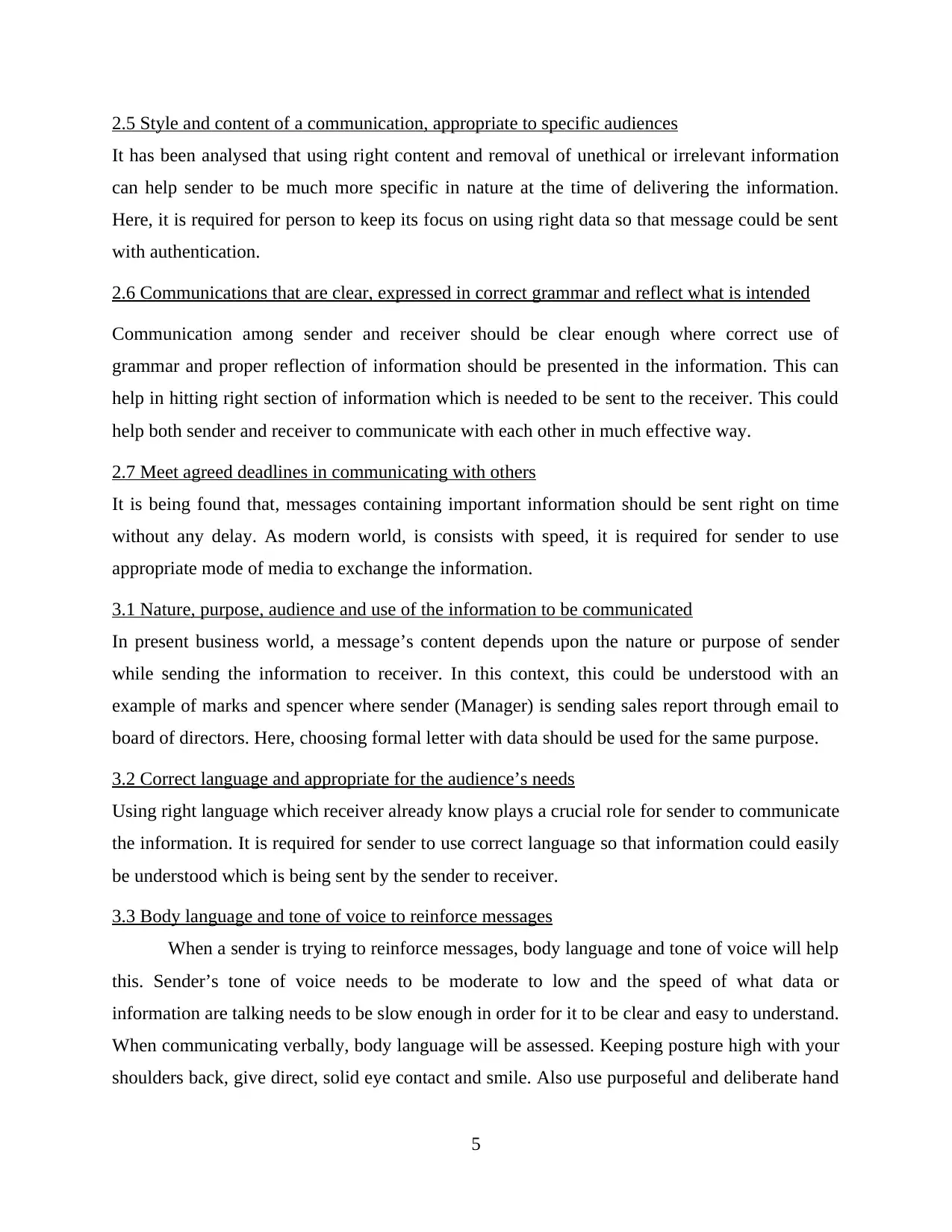
2.5 Style and content of a communication, appropriate to specific audiences
It has been analysed that using right content and removal of unethical or irrelevant information
can help sender to be much more specific in nature at the time of delivering the information.
Here, it is required for person to keep its focus on using right data so that message could be sent
with authentication.
2.6 Communications that are clear, expressed in correct grammar and reflect what is intended
Communication among sender and receiver should be clear enough where correct use of
grammar and proper reflection of information should be presented in the information. This can
help in hitting right section of information which is needed to be sent to the receiver. This could
help both sender and receiver to communicate with each other in much effective way.
2.7 Meet agreed deadlines in communicating with others
It is being found that, messages containing important information should be sent right on time
without any delay. As modern world, is consists with speed, it is required for sender to use
appropriate mode of media to exchange the information.
3.1 Nature, purpose, audience and use of the information to be communicated
In present business world, a message’s content depends upon the nature or purpose of sender
while sending the information to receiver. In this context, this could be understood with an
example of marks and spencer where sender (Manager) is sending sales report through email to
board of directors. Here, choosing formal letter with data should be used for the same purpose.
3.2 Correct language and appropriate for the audience’s needs
Using right language which receiver already know plays a crucial role for sender to communicate
the information. It is required for sender to use correct language so that information could easily
be understood which is being sent by the sender to receiver.
3.3 Body language and tone of voice to reinforce messages
When a sender is trying to reinforce messages, body language and tone of voice will help
this. Sender’s tone of voice needs to be moderate to low and the speed of what data or
information are talking needs to be slow enough in order for it to be clear and easy to understand.
When communicating verbally, body language will be assessed. Keeping posture high with your
shoulders back, give direct, solid eye contact and smile. Also use purposeful and deliberate hand
5
It has been analysed that using right content and removal of unethical or irrelevant information
can help sender to be much more specific in nature at the time of delivering the information.
Here, it is required for person to keep its focus on using right data so that message could be sent
with authentication.
2.6 Communications that are clear, expressed in correct grammar and reflect what is intended
Communication among sender and receiver should be clear enough where correct use of
grammar and proper reflection of information should be presented in the information. This can
help in hitting right section of information which is needed to be sent to the receiver. This could
help both sender and receiver to communicate with each other in much effective way.
2.7 Meet agreed deadlines in communicating with others
It is being found that, messages containing important information should be sent right on time
without any delay. As modern world, is consists with speed, it is required for sender to use
appropriate mode of media to exchange the information.
3.1 Nature, purpose, audience and use of the information to be communicated
In present business world, a message’s content depends upon the nature or purpose of sender
while sending the information to receiver. In this context, this could be understood with an
example of marks and spencer where sender (Manager) is sending sales report through email to
board of directors. Here, choosing formal letter with data should be used for the same purpose.
3.2 Correct language and appropriate for the audience’s needs
Using right language which receiver already know plays a crucial role for sender to communicate
the information. It is required for sender to use correct language so that information could easily
be understood which is being sent by the sender to receiver.
3.3 Body language and tone of voice to reinforce messages
When a sender is trying to reinforce messages, body language and tone of voice will help
this. Sender’s tone of voice needs to be moderate to low and the speed of what data or
information are talking needs to be slow enough in order for it to be clear and easy to understand.
When communicating verbally, body language will be assessed. Keeping posture high with your
shoulders back, give direct, solid eye contact and smile. Also use purposeful and deliberate hand
5
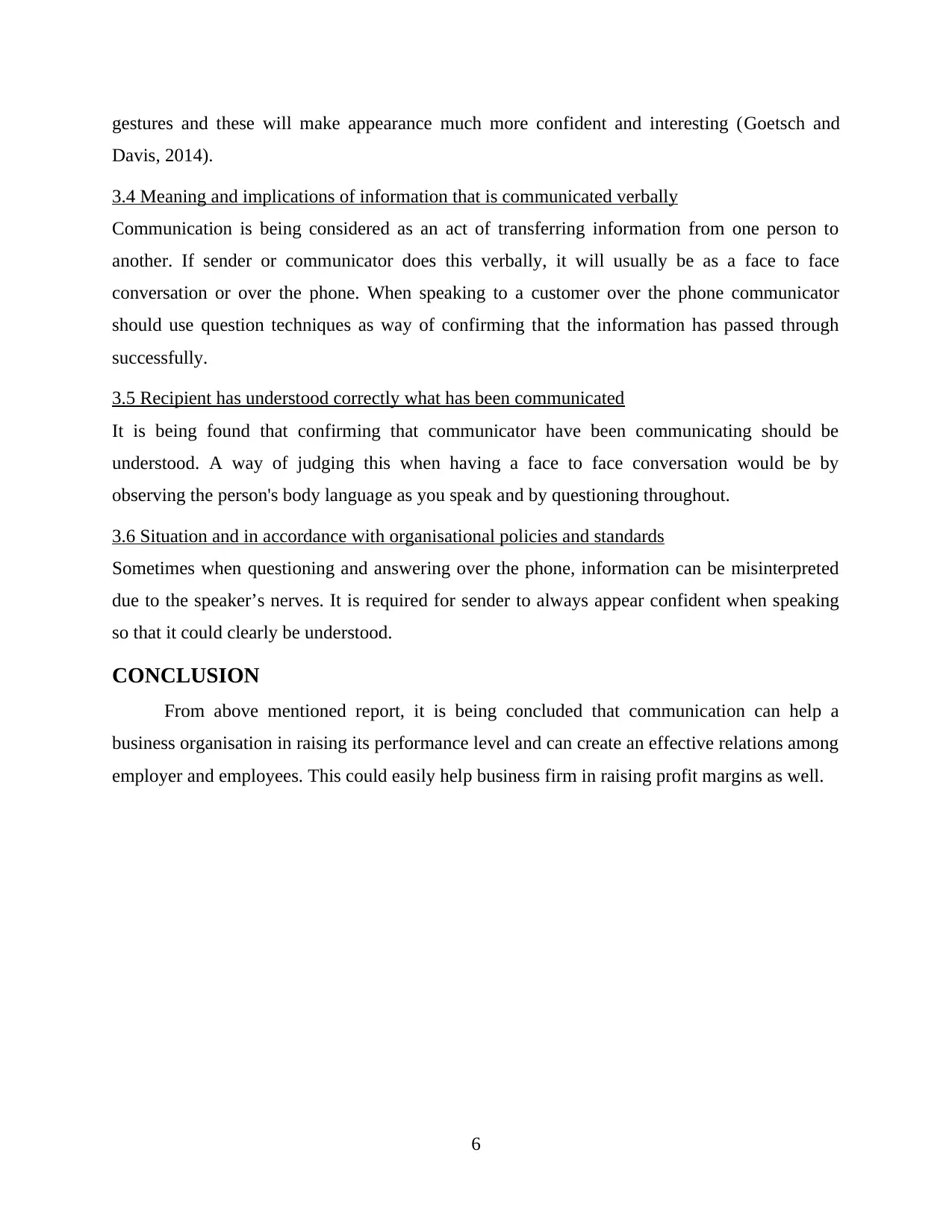
gestures and these will make appearance much more confident and interesting (Goetsch and
Davis, 2014).
3.4 Meaning and implications of information that is communicated verbally
Communication is being considered as an act of transferring information from one person to
another. If sender or communicator does this verbally, it will usually be as a face to face
conversation or over the phone. When speaking to a customer over the phone communicator
should use question techniques as way of confirming that the information has passed through
successfully.
3.5 Recipient has understood correctly what has been communicated
It is being found that confirming that communicator have been communicating should be
understood. A way of judging this when having a face to face conversation would be by
observing the person's body language as you speak and by questioning throughout.
3.6 Situation and in accordance with organisational policies and standards
Sometimes when questioning and answering over the phone, information can be misinterpreted
due to the speaker’s nerves. It is required for sender to always appear confident when speaking
so that it could clearly be understood.
CONCLUSION
From above mentioned report, it is being concluded that communication can help a
business organisation in raising its performance level and can create an effective relations among
employer and employees. This could easily help business firm in raising profit margins as well.
6
Davis, 2014).
3.4 Meaning and implications of information that is communicated verbally
Communication is being considered as an act of transferring information from one person to
another. If sender or communicator does this verbally, it will usually be as a face to face
conversation or over the phone. When speaking to a customer over the phone communicator
should use question techniques as way of confirming that the information has passed through
successfully.
3.5 Recipient has understood correctly what has been communicated
It is being found that confirming that communicator have been communicating should be
understood. A way of judging this when having a face to face conversation would be by
observing the person's body language as you speak and by questioning throughout.
3.6 Situation and in accordance with organisational policies and standards
Sometimes when questioning and answering over the phone, information can be misinterpreted
due to the speaker’s nerves. It is required for sender to always appear confident when speaking
so that it could clearly be understood.
CONCLUSION
From above mentioned report, it is being concluded that communication can help a
business organisation in raising its performance level and can create an effective relations among
employer and employees. This could easily help business firm in raising profit margins as well.
6
⊘ This is a preview!⊘
Do you want full access?
Subscribe today to unlock all pages.

Trusted by 1+ million students worldwide
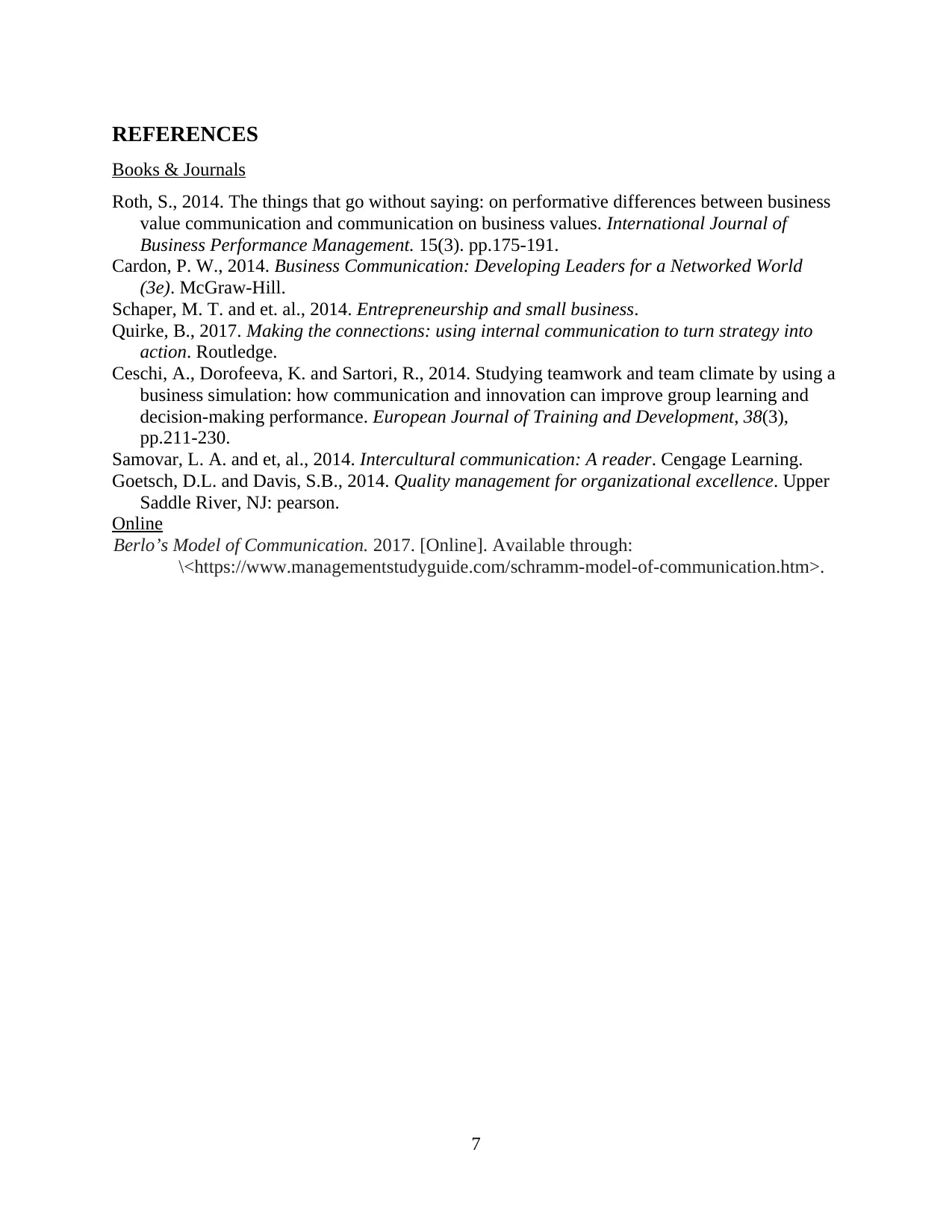
REFERENCES
Books & Journals
Roth, S., 2014. The things that go without saying: on performative differences between business
value communication and communication on business values. International Journal of
Business Performance Management. 15(3). pp.175-191.
Cardon, P. W., 2014. Business Communication: Developing Leaders for a Networked World
(3e). McGraw-Hill.
Schaper, M. T. and et. al., 2014. Entrepreneurship and small business.
Quirke, B., 2017. Making the connections: using internal communication to turn strategy into
action. Routledge.
Ceschi, A., Dorofeeva, K. and Sartori, R., 2014. Studying teamwork and team climate by using a
business simulation: how communication and innovation can improve group learning and
decision-making performance. European Journal of Training and Development, 38(3),
pp.211-230.
Samovar, L. A. and et, al., 2014. Intercultural communication: A reader. Cengage Learning.
Goetsch, D.L. and Davis, S.B., 2014. Quality management for organizational excellence. Upper
Saddle River, NJ: pearson.
Online
Berlo’s Model of Communication. 2017. [Online]. Available through:
\<https://www.managementstudyguide.com/schramm-model-of-communication.htm>.
7
Books & Journals
Roth, S., 2014. The things that go without saying: on performative differences between business
value communication and communication on business values. International Journal of
Business Performance Management. 15(3). pp.175-191.
Cardon, P. W., 2014. Business Communication: Developing Leaders for a Networked World
(3e). McGraw-Hill.
Schaper, M. T. and et. al., 2014. Entrepreneurship and small business.
Quirke, B., 2017. Making the connections: using internal communication to turn strategy into
action. Routledge.
Ceschi, A., Dorofeeva, K. and Sartori, R., 2014. Studying teamwork and team climate by using a
business simulation: how communication and innovation can improve group learning and
decision-making performance. European Journal of Training and Development, 38(3),
pp.211-230.
Samovar, L. A. and et, al., 2014. Intercultural communication: A reader. Cengage Learning.
Goetsch, D.L. and Davis, S.B., 2014. Quality management for organizational excellence. Upper
Saddle River, NJ: pearson.
Online
Berlo’s Model of Communication. 2017. [Online]. Available through:
\<https://www.managementstudyguide.com/schramm-model-of-communication.htm>.
7
Paraphrase This Document
Need a fresh take? Get an instant paraphrase of this document with our AI Paraphraser

8
1 out of 11
Related Documents
Your All-in-One AI-Powered Toolkit for Academic Success.
+13062052269
info@desklib.com
Available 24*7 on WhatsApp / Email
![[object Object]](/_next/static/media/star-bottom.7253800d.svg)
Unlock your academic potential
Copyright © 2020–2025 A2Z Services. All Rights Reserved. Developed and managed by ZUCOL.





